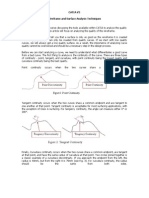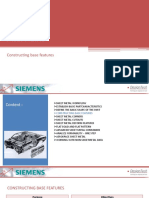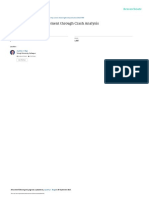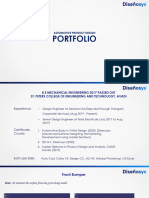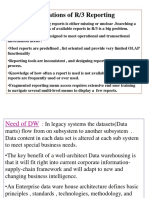BIW - Beads
Uploaded by
Arvind97Copyright:
Available Formats
BIW - Beads
Uploaded by
Arvind97Original Description:
Copyright
Available Formats
Share this document
Did you find this document useful?
Is this content inappropriate?
Copyright:
Available Formats
BIW - Beads
Uploaded by
Arvind97Copyright:
Available Formats
BIW - Beads
Overview: A bead forms a protrusion or depression in the sheet or solid body to
which it is applied. Beads are useful in the design of sheet metal products
because they add strength to the product or dissipate stress and control the
formability of the material during metal stamping operations.
Beads Types
There are three types of beads: circular, V-shaped, and U-shaped.
Bead Creation
There are many ways to create a bead formation. Functions that allow you to
sweep section data along guides work well for most formations. Using functions
that create tubular formation along a single centerline guide string can form
simple circular beads. The end run-out conditions are controlled by the bead
centerline. Some CAD systems offer bead functions within the sheet metal tools.
Some of the hardest areas to model on some beads are capping the ends or
blending the ends. In many situations, you can revolve the end face of the bead
to form this shape.
Determine Bead Shape
Create typical section curves, or if available, bead functions that most closely
resembles the design intent.
Determine Bead Placement Faces
Next, you need to determine the placement faces of the bead. The placement
face is one or more selected faces. The base of the bead follows the contours
of these faces.
Create Initial Bead Centerline
Create the initial bead centerline after you determine the shape and the
placement faces of the bead. The centerline defines the path of the bead.
Develop the centerline on the face if you are using a planar face. If you are
using a complex face, develop the bead centerline on a plane away from the
complex faces, then project the curves back to the contoured faces.
Develop centerline extensions in situations where the bead's end is not a full
radius as in some circular type beads.
You might also like
- Guide to Load Analysis for Durability in Vehicle EngineeringFrom EverandGuide to Load Analysis for Durability in Vehicle EngineeringP. Johannesson4/5 (1)
- Design of Lightweight Disc Brake Using Finite Element Analysis and Taguschi TechniqueNo ratings yetDesign of Lightweight Disc Brake Using Finite Element Analysis and Taguschi Technique11 pages
- Complete Passenger Car Design & Product DevelopmentNo ratings yetComplete Passenger Car Design & Product Development7 pages
- Durability Assessments of Motorcycle Handlebars Ken-Yuan Lin, 2005 XXXXXNo ratings yetDurability Assessments of Motorcycle Handlebars Ken-Yuan Lin, 2005 XXXXX25 pages
- Reducing and Optimising Tailgate Closing EffortsNo ratings yetReducing and Optimising Tailgate Closing Efforts10 pages
- Sae Technical Paper Series: Raviraj Nayak and Kee ImNo ratings yetSae Technical Paper Series: Raviraj Nayak and Kee Im8 pages
- Unigraphics NX Interview Questions and AnswersNo ratings yetUnigraphics NX Interview Questions and Answers8 pages
- Bumper Design Enhancement Through Crash AnalysisNo ratings yetBumper Design Enhancement Through Crash Analysis9 pages
- Continuity 1 - G0, G1, G2, G3 - 3ds Max - Autodesk Knowledge NetworkNo ratings yetContinuity 1 - G0, G1, G2, G3 - 3ds Max - Autodesk Knowledge Network11 pages
- Model and Analysis On Car Seat Mounting BracketNo ratings yetModel and Analysis On Car Seat Mounting Bracket6 pages
- Fact Sheet - Benchmarking of SAP BW Systems Benchmark Institute WuerzburgNo ratings yetFact Sheet - Benchmarking of SAP BW Systems Benchmark Institute Wuerzburg2 pages
- What Do You Mean by CATIA and The Scope of The Application?No ratings yetWhat Do You Mean by CATIA and The Scope of The Application?3 pages
- Introduction To Design For Assembly and Manufacturing: (Cost Effective)No ratings yetIntroduction To Design For Assembly and Manufacturing: (Cost Effective)81 pages
- Fender Wheel Arch Calculation: 1.1 Types of Fender Panels0% (1)Fender Wheel Arch Calculation: 1.1 Types of Fender Panels3 pages
- Catia V5R19: CATIA - Automotive Body in White Templates 2 (ABT)No ratings yetCatia V5R19: CATIA - Automotive Body in White Templates 2 (ABT)4 pages
- GRIEVE - 1997 - Design of A Lightweight Automotive Brake Disc Using Finite Element and Taguchi TechniquesNo ratings yetGRIEVE - 1997 - Design of A Lightweight Automotive Brake Disc Using Finite Element and Taguchi Techniques10 pages
- Automobile Seat Comfort Occupant Preferences vs. Anthropometric AccommodationNo ratings yetAutomobile Seat Comfort Occupant Preferences vs. Anthropometric Accommodation8 pages
- Freeform Surface Modelling Using NURBS SEMINAR REPORTNo ratings yetFreeform Surface Modelling Using NURBS SEMINAR REPORT24 pages
- Drawing A Hexafoil: Stonemasonry Technical Skills at Skillstech AustraliaNo ratings yetDrawing A Hexafoil: Stonemasonry Technical Skills at Skillstech Australia15 pages


